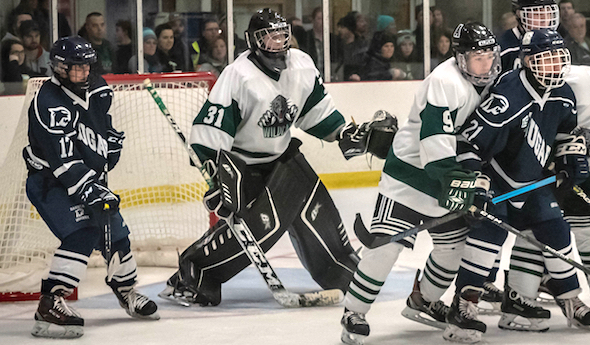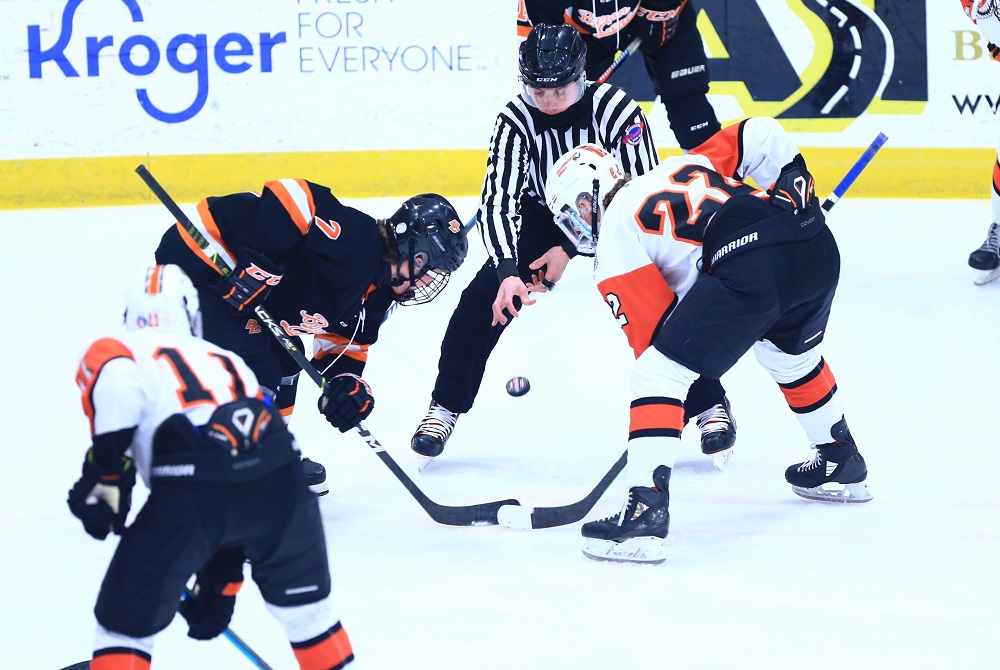
Alpena Goalie Surges to Statewide Stardom
January 4, 2019
By Chris Dobrowolski
Special for Second Half
ALPENA — Cooper Black has saved his best for last.
 It’s just among the many saves Alpena’s goalie has made so far during his senior season with the Wildcats’ ice hockey team.
It’s just among the many saves Alpena’s goalie has made so far during his senior season with the Wildcats’ ice hockey team.
Not only has Black emerged as Alpena’s top goaltender this year, after sharing the role a year ago, but he has put his name alongside the top goalies in the state. He’s No. 1 in the state in save percentage (.963), fourth in goals against average (0.90) and tied for fifth in wins (8) according to MI Hockey Hub as Alpena has surged to a 9-2-1 record.
“He’s been playing great, and that’s been a key to our success,” said Alpena head coach Chris Limback. “I always knew he had the talent. It was just a matter of putting it together and for him to realize it. He started to make some big saves, and his confidence grew. Then he became the goalie I always thought he could be.”
Black asserted himself as the Wildcats’ top netminder from the opening game this season and became irreplaceable as the starter as he built a scoreless streak of 258 minutes, 25 seconds to begin the year, including shutouts in five straight games.
“Coach gave me the first start, and I had a good game,” said Black. “That was just a confidence builder, and from there it just took off. It was really something special. I don’t think that (five straight shutouts) has happened here for quite a while. I definitely had some help from my teammates, obviously. They’re getting it done and playing good defense for me.”
Black admits not having confidence was an issue for him last year. That began to change in the offseason when he received some extra work with a goalie coach, then tried out and earned a roster spot in the Michigan Development Hockey League — a collection of six teams that play from August until October and feature some of the top players from around the state.
“He played in that, and he gained a lot of confidence there,” said Limback. “He realized, ‘Hey, I can play with the best kids in the state.’ He looks so in control of the game. I think it’s all confidence. He finally believes in himself. He’s using his size to his advantage. He’s playing like a confident goalie instead of playing afraid.”
 Black didn’t know if he would be selected to play in the MDHL out of the dozens of goalies who tried out, but he showcased his ability at the right time to get picked for a team and ultimately helped the squad he was playing for reach the semifinals of the league’s postseason playoffs.
Black didn’t know if he would be selected to play in the MDHL out of the dozens of goalies who tried out, but he showcased his ability at the right time to get picked for a team and ultimately helped the squad he was playing for reach the semifinals of the league’s postseason playoffs.
“It was definitely something that helped me develop as a player,” said Black. “If anyone got a chance to go play in it, I would suggest they do it. It’s something where you get a lot of exposure and you get to play against the best players in the state. It’s a really good league. I was just stoked to be there.”
A dominant goalie can go a long way in hockey, and Alpena has certainly reaped the benefits of having the 6-foot-2, 163-pound Black standing between the pipes.
“You know you have a chance to win every game,” said Limback. “Even if your (defense) or your forwards aren’t having a great game, you know he’s always back there in case you make an error. It’s a great feeling for our team to have.”
Black is one of nine seniors on a veteran Alpena team. Owen Limback and Anthony Berg anchor the defense, while Colby Plowman and Kyle VanDusen are the top producers on offense for the Wildcats, who were 15-7-3 last season.
“We have seniors in all the key positions,” said Chris Limback. “It’s an older team. It’s a group of kids I’ve had for many years, through minor hockey and all the way through.”
That experienced group won its first seven contests of the season and has not been shy about facing some of the elite teams in the state. In fact, the Wildcats snapped reigning Division 3 champion Detroit Country Day’s 27-game winning streak with a 1-1 draw at the Division 3 Showcase in Gaylord last month. That game created quite the pregame buzz as it matched Black against the state’s reigning Mr. Hockey in Country Day goalie Sam Evola.
Country Day appeared to be on its way to a 28th straight win until VanDusen netted a goal in the final second.
“It was really good game,” said Black. “I think Sam made a really good save 20 seconds in. He was aggressive and made a really good save to keep the score 0-0. They squeezed one by me from the point. It took a couple of bounces, and I got too impatient and it just slipped by me. Our whole line at the end made a great play — Kyle just got a one-timer and put it perfectly. Sam, there wasn’t much he could do. I thought he played pretty well in that game. I was definitely a little more motivated. I wanted to win that game so bad. That was definitely the highlight of the season so far.”
Black is hoping there are more highlights to come. He believes the Wildcats have what it takes to win the Big North Conference and make a deep run in the postseason. And, if he continues playing like he has this season, there is likely to be some junior-level teams seeking a player of his caliber to play in goal.
“He’s a great kid,” said Chris Limback. “Smart academically and a fun kid to coach. It’s nice to see that doors are opening up for him. Now he’ll have some options to go for juniors and keep pursuing his dream of playing college hockey.”
 Chris Dobrowolski has covered northern Lower Peninsula sports since 1999 at the Ogemaw County Herald, Alpena News, Traverse City Record-Eagle and currently as sports editor at the Antrim Kalkaska Review since 2016. He can be reached at [email protected] with story ideas for Manistee, Wexford, Missaukee, Roscommon, Ogemaw, Iosco, Alcona, Oscoda, Crawford, Kalkaska, Grand Traverse, Benzie, Leelanau, Antrim, Otsego, Montmorency, Alpena, Presque Isle, Cheboygan, Charlevoix and Emmet counties.
Chris Dobrowolski has covered northern Lower Peninsula sports since 1999 at the Ogemaw County Herald, Alpena News, Traverse City Record-Eagle and currently as sports editor at the Antrim Kalkaska Review since 2016. He can be reached at [email protected] with story ideas for Manistee, Wexford, Missaukee, Roscommon, Ogemaw, Iosco, Alcona, Oscoda, Crawford, Kalkaska, Grand Traverse, Benzie, Leelanau, Antrim, Otsego, Montmorency, Alpena, Presque Isle, Cheboygan, Charlevoix and Emmet counties.
PHOTOS: (Top) Alpena goalie Cooper Black guards the net during the Wildcats’ game against Macomb Dakota earlier this season. (Middle) Black ranks among the top goalies in the state in his first season as the team’s fulltime starter. (Photos courtesy of Black family.)

Be the Referee: Hockey Delayed Offside
By
Brent Rice
MHSAA Assistant Director
February 16, 2022
Be The Referee is a series of short messages designed to help educate people on the rules of different sports, to help them better understand the art of officiating, and to recruit officials.
Below is this week's segment – Hockey Delayed Offside - Listen
Bundle up because we are on the ice today with a delayed offside situation in hockey.
During the delayed offsides, the puck is shot directly on goal. Should the official:
► Whistle the play dead and restart with a faceoff from the offending team zone?
► Whistle the play dead and restart with a faceoff from the closest dot from where the shot was taken?
► Whistle the play dead and restart with a faceoff from the neutral zone?
► Or – let the play continue.
If you said let the play continue, you are correct. In this situation, the play should be allowed to continue until all offensive players clear the offensive zone.
The next time there’s a delayed offsides call with a shot on goal, you’ll know what to do.
Previous editions
Feb. 10: Basketball Timeout - Listen
Feb. 3: Basketball Video Review - Listen
Jan. 27: Wrestling Inspections - Listen
Dec. 16: Ball Over Backboard - Listen
Dec. 9: Winter Officials Mechanics - Listen
Nov. 26: Instant Replay - Listen
Nov. 11: Tourney Selection - Listen
Nov. 4: Receiver Carried Out of End Zone – Listen
Oct. 28: Volleyball Back-Row Block – Listen
Oct. 21: Soccer Disallowed Goal – Listen
Sept 30: Field Goal Falls Short – Listen
Sept. 23: Volleyball Obstruction – Listen
Sept. 16: Catch or No Catch – Listen
Sept. 9: Intentional Grounding – Listen
Sept. 2: Pass Interference – Listen
Aug. 26: Protocols and Mechanics – Listen

